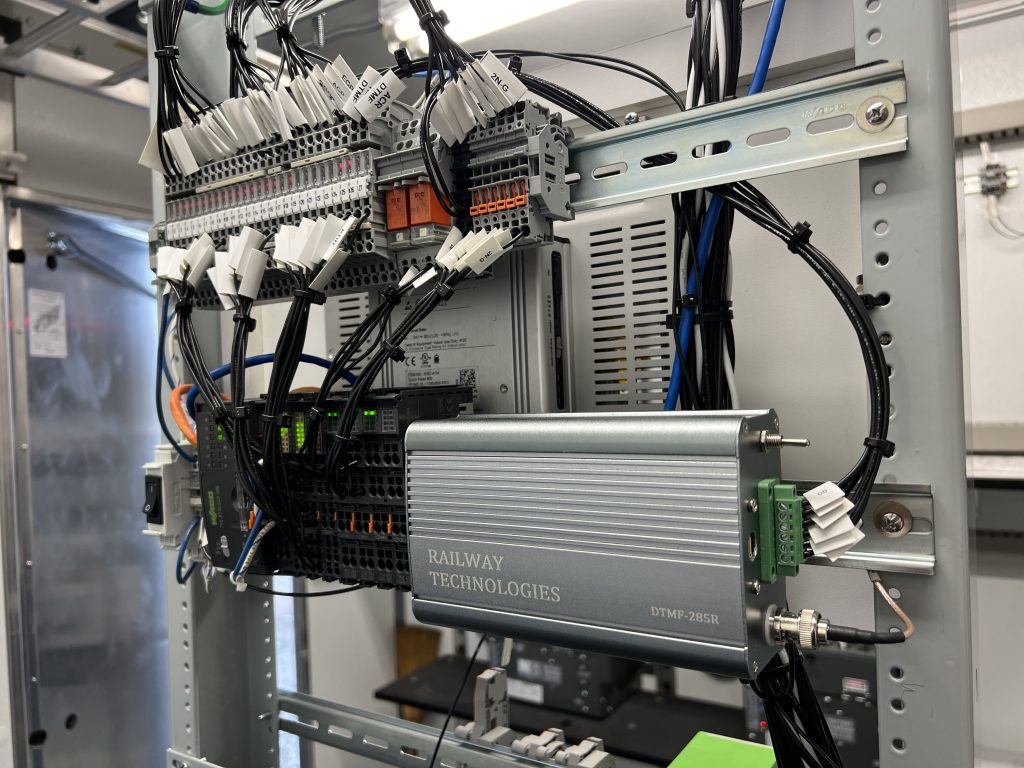DTMF Stand-Alone Module

Overview
Railway Technologies is proud to introduce our advanced DTMF (Dual-Tone Multi-Frequency) stand-alone module – DTMF-285R. This module is a testament to our continuous commitment to delivering high-quality, reliable, and technologically advanced products for railway applications.
Features
This DTMF module is built around a custom-designed ATmega32u4 based circuit board. The Atmega32u4 microcontroller is a low-power, high-performance chip featuring 32KB ISP flash memory, 2.5KB SRAM, 1KB EEPROM, and a clock speed of 16MHz. It has 23 general purpose I/O lines, 32 general-purpose working registers, three flexible timer/counters with compare modes, internal and external interrupts, and a serial programmable USART.
These features enable the DTMF-285R to provide efficient, reliable, and responsive controls for a variety of railway applications. The module uses DTMF signaling, the same technology found in touch-tone telephones, to control a pair of relays that can be used to activate railway crossings, signals, or other equipment.
Versatile Radio Integration
The DTMF-285R is not just designed for single-radio compatibility. While it interfaces seamlessly with the Ritron DTX radio, a high-performance, durable, and reliable radio solution ideal for railway applications, our module is also compatible with a wide range of other data radios. This flexibility enables you to leverage the DTMF-285R module within diverse communication infrastructures, ensuring optimal performance across various operational scenarios.
With its clear and long-range signal transmission, the integration of these radios can effectively send DTMF commands to the module over vast distances. This allows remote operation of railway equipment from a centralized control station, thus enhancing the efficiency and reliability of railway operations.
Whether you’re already using a specific data radio or considering a new one, the DTMF-285R can seamlessly integrate into your setup, providing you the control and adaptability your railway operations require.
Interactive Menu and User Control
The DTMF-285R features an interactive menu system that allows users to control the module’s operations through a serial terminal. The menu system includes options to test the relays, display information, access help, and set new DTMF codes for relay activation, deactivation, timers, and location details.
The system operates through a series of menu options, accessible by sending specific characters via the serial terminal. Users can easily navigate through these options, making changes as required, which are then stored in the EEPROM for persistent operation across power cycles.
The code running the system is highly modular, reliable, and efficient, utilizing the Atmega32u4’s capabilities to the fullest.
Use Cases
The DTMF-285R module is ideal for managing remote railway operations such as:
- Activating and deactivating railway crossing signals at predetermined times or upon receiving specific commands.
- Managing multiple railway signal installations from a centralized control station.
- Testing and troubleshooting railway installations remotely.
Conclusion
The DTMF-285R module combines advanced microcontroller technology with robust radio communications to deliver a powerful, flexible, and reliable solution for remote railway equipment control. With its interactive menu and robust code, this module is easy to use and capable of managing complex operations, making it an essential part of any modern railway system.
Get Started with DTMF-285R
To make your journey with our DTMF-285R as smooth as possible, we’ve prepared a detailed guide that will walk you through the process of setting up your new module step by step.
Ready to harness the full potential of the DTMF-285R? Click here for setup instructions. Let’s get your railway operations running more efficiently than ever before.
Trust Railway Technologies for your railway equipment control needs. For more information, please contact us at Info@Railway-Technologies.com.